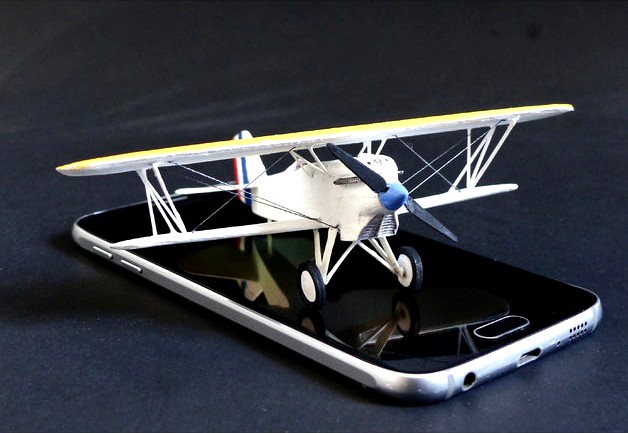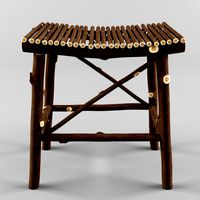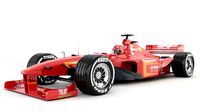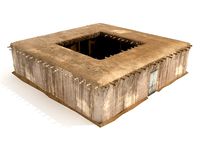Thingiverse

Curtiss P-1 Hawk - Interwar Biplane (1/72) by Erich_with_an_H
by Thingiverse
Last crawled date: 3 years ago
Aerospace technology advanced very quickly in the years between the First and Second World Wars. Over roughly twenty years, the state of the art evolved from fabric-covered and wire-braced open-cockpit biplanes, to sleek, metal-skinned monoplanes with retractable landing gear and enclosed cockpits. Generations of aircraft passed quickly, and many airframes were obsolete after only a few years in service.
The American-designed Curtiss P-1, which entered service in 1924, shows an early stage in that evolution. Its construction and overall layout, with the cockpit set far back behind an inline engine and fuel tank, followed the German Fokker D VII, which had arguably been the best fighter of the late war. After the war, many D VIIs had been seized by the Allies and studied.
The Curtiss P-1 was a simple machine by later standards—you can see its few indicators, controls, and its very rudimentary gunsight in this cockpit panorama from the Naval Aviation Museum. (This is the nearly identical naval F6C-1).
On the other hand, certain aspects of the P-1 reflect emerging post-war advances. Its water cooled inline engine, the 443 hp (330 kW) Curtiss D-12, was substantially more powerful than the last generation of First World War inline engines such as the Hispano-Suiza 8 or the BMW IIIa, which were around 200-230hp (~150-170kw). The D-12 was also the first aircraft engine to incorporate a cast aluminum engine block, giving it a very high power-to-weight ratio.
This powerful engine made the P-1 very fast for its time. The D-12 had powered the first aircraft past 200mph, and pushed the P-1’s racing precursor, the R-6 to average speeds above 200mph. The P-1’s various derivatives won many air races and set a number of speed records.
This P-1's sleek Art Deco lines reflect its racing heritage. Like a number of WW1-era fighters, the P-1 was equipped with two machine guns in front of the cockpit. Unlike its precursors, its guns were hidden under a streamlined fairing. Likewise, most of the inline-powered fighters of late WW1 (D VII, SPAD series, S.E.5) had a snub-nosed look because the radiators were located in front of the engine. The P-1 placed the radiator in a streamlined fairing under the fuselage, an arrangement that later became standard.The Base of the Tree
The P-1's airframe proved extraordinarily adaptable. The family of aircraft that developed from it is sometimes referred to as the “Curtiss Hawks”. You can imagine the P-1 at the base of a branching tree. Of course, all aircraft are part of an evolution from one thing to the next, but the same fundamental design is visible throughout the Hawk line. I can’t think of another airframe that has gone through so many variations.
In army service it underwent a series of incremental improvements, ultimately leading to the P-6E, delivered between 1932 and 1934, which featured a more streamlined front section, a three-bladed propeller, wheel spats, and a next-generation V-1570C engine rated at 700hp.
In 1925, the P-1 entered US navy service as the F6C. The F6C-2 and 3 models were modified with arrestor hooks and strengthened landing gear for use on early US aircraft carriers. These were the last aircraft with inline engines used on American carriers. Beginning with the F6C-4, the airframe was fitted with an increasingly powerful series of Pratt and Whitney radial engines. Air-cooled radials were mechanically simpler and easier to maintain at sea.
With the adoption of the radial engine in navy service, the plane began to change very noticeably. By 1932, the navy radial-powered Hawk line was developed into the F11C Goshawk, which featured aerodynamic landing gear spats and a cowling around the radial engine. This evolved into the BF2C-1, a carrier-born fighter-bomber, first delivered in 1934, which looks a bit like a pregnant guppy due to a bulge housing hand-cranked retractable landing gear.
Another branch of the Hawk tree emerged when the design sprouted a second seat and a larger wing to become the Falcon series.. First introduced in 1925, the falcons were used by the army as trainers and attack planes, typically with a gunner in a second seat behind the pilot. They were also used as radial-powered observation planes and dive bombers by the navy. The ultimate version was the radial-engined F8C Helldiver dive bomber variant, which was probably the Hawk branch furthest from P-1 root. These were the planes that attacked King-Kong at the top of the Empire State Building in the 1933 film.
An article written in 1934 counted "some thirty-five more or less distinct hawk types..." The Hawk airframe was fitted with skis to operate off snowy fields, and floats to operate as a seaplane . It was used to pioneer aircraft carrier operations, as well as naval dive bombing. Various versions of the two-seat Falcon variant were used as mail carriers, with the front seat space used for storage. The hawk airframe was modified several times for racing, by both the American army and navy, sometimes pretty radically. Hawks were fitted with a staggering variety of experimental engines, superchargers, cooling systems, and cowlings. They were exported around the world, from Cuba to Turkey, often in unique variants.
Despite their wide adoption, the Curtiss Hawks rarely saw conflict. The notable exception was their Chinese service. Already close to obsolete when the first Hawk IIs were purchased by the Chinese government in 1933, they were badly outclassed by newer Japanese aircraft in the Sino-Japanese War that began in 1937.American Century
At the beginning of the 20th century, the American military was small compared to the European powers. By its end, it had grown into the most disproportionately powerful military that has probably ever existed, at least in terms of wealth, resources, and technological sophistication. Within the field of aviation, the interwar period is especially interesting. During the First World War, the United States relied on France and Britain—mostly France—for its military aircraft. By the Second World War, practically every major allied power had adopted American aircraft to some extent, or would come to rely on them during the war.
The P-1 was an important step in the development of the American military aircraft industry. It also represents a period when the tactical possibilities for using aircraft were rapidly changing, leading to many new ideas, and more than a few dead ends. The United States, with its enormous wealth and industrial capacity, played an ever greater role in this process of military experimentation.
The P-1 entered service in 1924, a year after its prototype, the PW-8, had flown. A decade later, though still in service, the airframe was close to obsolete. This was the rapid evolution of a technology in its infancy. Compare this to the current trillion-dollar F-35 program, whose prototype flew in the year 2000 and is only now, eighteen years later, finishing its testing phase. The F-35 platform is expected to serve for another fifty years as its designers incrementally upgrade and replace its enormous network of complex systems.
The American-designed Curtiss P-1, which entered service in 1924, shows an early stage in that evolution. Its construction and overall layout, with the cockpit set far back behind an inline engine and fuel tank, followed the German Fokker D VII, which had arguably been the best fighter of the late war. After the war, many D VIIs had been seized by the Allies and studied.
The Curtiss P-1 was a simple machine by later standards—you can see its few indicators, controls, and its very rudimentary gunsight in this cockpit panorama from the Naval Aviation Museum. (This is the nearly identical naval F6C-1).
On the other hand, certain aspects of the P-1 reflect emerging post-war advances. Its water cooled inline engine, the 443 hp (330 kW) Curtiss D-12, was substantially more powerful than the last generation of First World War inline engines such as the Hispano-Suiza 8 or the BMW IIIa, which were around 200-230hp (~150-170kw). The D-12 was also the first aircraft engine to incorporate a cast aluminum engine block, giving it a very high power-to-weight ratio.
This powerful engine made the P-1 very fast for its time. The D-12 had powered the first aircraft past 200mph, and pushed the P-1’s racing precursor, the R-6 to average speeds above 200mph. The P-1’s various derivatives won many air races and set a number of speed records.
This P-1's sleek Art Deco lines reflect its racing heritage. Like a number of WW1-era fighters, the P-1 was equipped with two machine guns in front of the cockpit. Unlike its precursors, its guns were hidden under a streamlined fairing. Likewise, most of the inline-powered fighters of late WW1 (D VII, SPAD series, S.E.5) had a snub-nosed look because the radiators were located in front of the engine. The P-1 placed the radiator in a streamlined fairing under the fuselage, an arrangement that later became standard.The Base of the Tree
The P-1's airframe proved extraordinarily adaptable. The family of aircraft that developed from it is sometimes referred to as the “Curtiss Hawks”. You can imagine the P-1 at the base of a branching tree. Of course, all aircraft are part of an evolution from one thing to the next, but the same fundamental design is visible throughout the Hawk line. I can’t think of another airframe that has gone through so many variations.
In army service it underwent a series of incremental improvements, ultimately leading to the P-6E, delivered between 1932 and 1934, which featured a more streamlined front section, a three-bladed propeller, wheel spats, and a next-generation V-1570C engine rated at 700hp.
In 1925, the P-1 entered US navy service as the F6C. The F6C-2 and 3 models were modified with arrestor hooks and strengthened landing gear for use on early US aircraft carriers. These were the last aircraft with inline engines used on American carriers. Beginning with the F6C-4, the airframe was fitted with an increasingly powerful series of Pratt and Whitney radial engines. Air-cooled radials were mechanically simpler and easier to maintain at sea.
With the adoption of the radial engine in navy service, the plane began to change very noticeably. By 1932, the navy radial-powered Hawk line was developed into the F11C Goshawk, which featured aerodynamic landing gear spats and a cowling around the radial engine. This evolved into the BF2C-1, a carrier-born fighter-bomber, first delivered in 1934, which looks a bit like a pregnant guppy due to a bulge housing hand-cranked retractable landing gear.
Another branch of the Hawk tree emerged when the design sprouted a second seat and a larger wing to become the Falcon series.. First introduced in 1925, the falcons were used by the army as trainers and attack planes, typically with a gunner in a second seat behind the pilot. They were also used as radial-powered observation planes and dive bombers by the navy. The ultimate version was the radial-engined F8C Helldiver dive bomber variant, which was probably the Hawk branch furthest from P-1 root. These were the planes that attacked King-Kong at the top of the Empire State Building in the 1933 film.
An article written in 1934 counted "some thirty-five more or less distinct hawk types..." The Hawk airframe was fitted with skis to operate off snowy fields, and floats to operate as a seaplane . It was used to pioneer aircraft carrier operations, as well as naval dive bombing. Various versions of the two-seat Falcon variant were used as mail carriers, with the front seat space used for storage. The hawk airframe was modified several times for racing, by both the American army and navy, sometimes pretty radically. Hawks were fitted with a staggering variety of experimental engines, superchargers, cooling systems, and cowlings. They were exported around the world, from Cuba to Turkey, often in unique variants.
Despite their wide adoption, the Curtiss Hawks rarely saw conflict. The notable exception was their Chinese service. Already close to obsolete when the first Hawk IIs were purchased by the Chinese government in 1933, they were badly outclassed by newer Japanese aircraft in the Sino-Japanese War that began in 1937.American Century
At the beginning of the 20th century, the American military was small compared to the European powers. By its end, it had grown into the most disproportionately powerful military that has probably ever existed, at least in terms of wealth, resources, and technological sophistication. Within the field of aviation, the interwar period is especially interesting. During the First World War, the United States relied on France and Britain—mostly France—for its military aircraft. By the Second World War, practically every major allied power had adopted American aircraft to some extent, or would come to rely on them during the war.
The P-1 was an important step in the development of the American military aircraft industry. It also represents a period when the tactical possibilities for using aircraft were rapidly changing, leading to many new ideas, and more than a few dead ends. The United States, with its enormous wealth and industrial capacity, played an ever greater role in this process of military experimentation.
The P-1 entered service in 1924, a year after its prototype, the PW-8, had flown. A decade later, though still in service, the airframe was close to obsolete. This was the rapid evolution of a technology in its infancy. Compare this to the current trillion-dollar F-35 program, whose prototype flew in the year 2000 and is only now, eighteen years later, finishing its testing phase. The F-35 platform is expected to serve for another fifty years as its designers incrementally upgrade and replace its enormous network of complex systems.
Similar models
3d_export
$60

Curtiss P-40 Warhawk
...f the p-40 ceased, 13,738 had been built, all at curtiss-wright corporation's main production facilities in buffalo, new york
cg_trader
free

Curtiss P 40
...ties at buffalo, new york. (source wikipedia) blender flightgear aircraft historical lowpoly challenge historic historic aircraft
3dwarehouse
free

Curtiss P-40 Kityhawk
...he p-40 ceased, 13,738 had been built,3] all at curtiss-wright corporation's main production facilities at buffalo, new york.
3dwarehouse
free

Curtiss BF2C Goshawk
...r_force #aircraft #airplane #bf2c #curtiss #fighter #goshawk #grumman #jet #marines #military #navy #pav #phantom #rafale #tomcat
3d_export
$60

curtiss p-36 hawk
...n of combat aircraft—a sleek monoplane design with a retractable undercarriage making extensive use of metal in its construction.
cg_trader
$69

Curtiss P-6 Hawk
... in the late 1920s with the united states army air corps and operated until the late 1930s prior to the outbreak of world war ii.
cg_trader
$13

Very simple Brewster F2A Buffalo
...ircraft airplane army vehicle wwii weapon military vehicle historic historic aircraft aircraft air plane star navy us carrier sea
cg_trader
$79

Curtiss P-36A Hawk
...k aircraft plane warplane military historic ww2 american fighter curtiss p 36a hawk historic aircraft military aircraft ww2 plane
cg_trader
$89

Curtiss P-36C Hawk V01 USAAF
... raid on pearl harbor. these aircraft were fairly successful even though throughout the early war they were considered obsolete.
cg_trader
$89

Curtiss P-36C Hawk V08 USAAF
... raid on pearl harbor. these aircraft were fairly successful even though throughout the early war they were considered obsolete.
Interwar
3d_export
$60

Avro 621 Trainer
...trainer was a two-seat british radial-engined biplane from the interwar period. it was a simple but rugged basic trainer...
thingiverse
free

Dice for A World Aflame game by Nihvu
...numbers 8,9,9,10,10,11). these are good for a world aflame interwar wargame rules, because normal movement for infantry is average...
thingiverse
free

Amiot 143M by onintothevalleyofdeathroadthe600
...amiot 143m by onintothevalleyofdeathroadthe600 thingiverse during the interwar period the french experimented with angular aircraft. and they...
thingiverse
free

M1918 155mm Howitzer easy print by WindhamGraves
...changed for looks/ printability. if you want the ww1/ interwar version, swap out the tire wheels for wagon wheels....
thingiverse
free

Bell YMF-1 Airacuda by onintothevalleyofdeathroadthe600
...airacuda by onintothevalleyofdeathroadthe600 thingiverse the bell airacuda was an interwar design based around the concept of a heavy fighter....
blendswap
free

Vickers Vimy
...setting several notable records in long-distance flights in the interwar period, the most celebrated of which was the first...
thingiverse
free

Tatra OA vz.30 Armoured Car by deweycat
...deweycat thingiverse this is a 28mm model of the interwar czech oa vz.30 armoured car. here is a brief...
3dcadbrowser
free

AMC-35
...was a french medium cavalry tank of the later interwar era that served in the second world war. it...
renderosity
$9

Steampunk Soldier Helmet
...combines the aesthetics of the diesel-based technology of the interwar period through to the 1950s with retro-futuristic technology and...
Erich
turbosquid
$10

Chandelier Erich Maytoni
...3d model chandelier erich maytoni for download as max and obj on turbosquid: 3d models for games, architecture, videos. (1564116)
turbosquid
$10

Table Lamp of Erich Maytoni
...model table lamp of erich maytoni for download as max and obj on turbosquid: 3d models for games, architecture, videos. (1564113)
turbosquid
$10

Wall Scone Erich Maytoni
...3d model wall scone erich maytoni for download as max and obj on turbosquid: 3d models for games, architecture, videos. (1564099)
turbosquid
$10

Floor Lamp Erich Maytoni
...3d model floor lamp erich maytoni for download as max and obj on turbosquid: 3d models for games, architecture, videos. (1564098)
turbosquid
$10

Wall Sconce Erich Maytoni
...d model wall sconce erich maytoni for download as max and obj on turbosquid: 3d models for games, architecture, videos. (1568611)
turbosquid
$10

Wall light Erich Maytoni
...el wall light erich maytoni for download as max, max, and obj on turbosquid: 3d models for games, architecture, videos. (1620964)
turbosquid
$10

Floor Lamp Erich Maytoni
...el floor lamp erich maytoni for download as max, max, and obj on turbosquid: 3d models for games, architecture, videos. (1620961)
turbosquid
$10

Floor lamp Maytoni Erich MOD221
... 3d model floor lamp maytoni erich mod221 for download as max on turbosquid: 3d models for games, architecture, videos. (1312815)
turbosquid
$8

Floor Lamp Erich Maytoni Modern
... 3d model floor lamp erich maytoni modern for download as max on turbosquid: 3d models for games, architecture, videos. (1677279)
turbosquid
$8

Table Lamp Erich Maytoni Modern
... 3d model table lamp erich maytoni modern for download as max on turbosquid: 3d models for games, architecture, videos. (1676859)
Curtiss
3d_export
$17

Curtiss P-40E Kittyhawk
...curtiss p-40e kittyhawk
3dexport
curtiss p-40e kittyhawk
turbosquid
$55

Curtiss P6E Hawk
...d
royalty free 3d model curtiss p6e hawk for download as 3ds on turbosquid: 3d models for games, architecture, videos. (1494184)
3d_export
$60

curtiss sb2c helldiver
...nited states navy (usn), in pacific theaters, it supplemented and replaced the douglas sbd dauntless. a few survivors are extant.
turbosquid
$15

Curtiss P-40
... available on turbo squid, the world's leading provider of digital 3d models for visualization, films, television, and games.
turbosquid
free

Curtiss 18-T
... available on turbo squid, the world's leading provider of digital 3d models for visualization, films, television, and games.
cg_studio
$169

Curtiss F11C Goshawk3d model
...l
cgstudio
.3ds .c4d .max .obj - curtiss f11c goshawk 3d model, royalty free license available, instant download after purchase.
turbosquid
$90

Curtiss P-40 plane
... available on turbo squid, the world's leading provider of digital 3d models for visualization, films, television, and games.
3d_export
$60

curtiss p-36 hawk
...n of combat aircraft—a sleek monoplane design with a retractable undercarriage making extensive use of metal in its construction.
3d_export
$60

Curtiss P-40 Warhawk
...f the p-40 ceased, 13,738 had been built, all at curtiss-wright corporation's main production facilities in buffalo, new york
turbosquid
$25

Curtiss P-40 Warhawk Low Poly
...ee 3d model curtiss p-40 warhawk low poly for download as fbx on turbosquid: 3d models for games, architecture, videos. (1598649)
Biplane
3d_export
free

biplan
...biplan
3dexport
biplan
design_connected
$13

Biplan
...biplan
designconnected
ligne roset biplan computer generated 3d model. designed by atelier bl 119.
3d_export
$5

biplane lowpoly
...biplane lowpoly
3dexport
biplane lowpoly
turbosquid
free

Biplane
...osquid
free 3d model biplane for download as sldas and sldpr on turbosquid: 3d models for games, architecture, videos. (1574145)
turbosquid
$1

Biplane
...lty free 3d model biplane for download as blend, fbx, and obj on turbosquid: 3d models for games, architecture, videos. (1517529)
turbosquid
$30

Biplane
... available on turbo squid, the world's leading provider of digital 3d models for visualization, films, television, and games.
turbosquid
$10

Biplane
... available on turbo squid, the world's leading provider of digital 3d models for visualization, films, television, and games.
turbosquid
$8

BIPLANE
... available on turbo squid, the world's leading provider of digital 3d models for visualization, films, television, and games.
turbosquid
$5

Biplane
... available on turbo squid, the world's leading provider of digital 3d models for visualization, films, television, and games.
turbosquid
$5

Biplane
... available on turbo squid, the world's leading provider of digital 3d models for visualization, films, television, and games.
Hawk
3ddd
$1

Hawk Chair
...hawk chair
3ddd
hawk chair
resident, hawk chair. h: 770, w: 500, l:490
3d_export
$7

Hawk
...hawk
3dexport
the model is divided into 5 parts
turbosquid
$80

Black Hawk
...bosquid
royalty free 3d model black hawk for download as max on turbosquid: 3d models for games, architecture, videos. (1662435)
turbosquid
$22

Hunting the hawk
...d
royalty free 3d model hunting the hawk for download as stl on turbosquid: 3d models for games, architecture, videos. (1306651)
turbosquid
$19

Helicopter Hawk
...id
royalty free 3d model helicopter hawk for download as max on turbosquid: 3d models for games, architecture, videos. (1240870)
turbosquid
$99

Galaxy Hawk
... available on turbo squid, the world's leading provider of digital 3d models for visualization, films, television, and games.
turbosquid
$49

Aluminium Hawk
... available on turbo squid, the world's leading provider of digital 3d models for visualization, films, television, and games.
turbosquid
$40

C-Hawk
... available on turbo squid, the world's leading provider of digital 3d models for visualization, films, television, and games.
turbosquid
$40

Hawk Monster
... available on turbo squid, the world's leading provider of digital 3d models for visualization, films, television, and games.
turbosquid
$20

Hawk Blade
... available on turbo squid, the world's leading provider of digital 3d models for visualization, films, television, and games.
72
design_connected
$29

72
...72
designconnected
restoration hardware 72" the petite kensington leather sofa computer generated 3d model.
design_connected
$11

Neolitico 72
...neolitico 72
designconnected
reflex angelo neolitico 72 computer generated 3d model.
design_connected
$11

Tree 72
...tree 72
designconnected
reflex angelo tree 72 dining tables computer generated 3d model. designed by n/a.
3ddd
$1

Pillows 72
...pillows 72
3ddd
подушка
pillows 72. i hope you like it and buy it . thank you so much!
3ddd
$1

Neolitico 72
...reflex angelo , круглый
фабрика angelo|reflex, серия neolitico,72/. (d1400.h720), италия
3ddd
$1

Eleganza Pagina 72
...eleganza pagina 72
3ddd
консоль
eleganza pagina 72
3d_export
$65

tank t 72
...tank t 72
3dexport
tank t 72 3d model
turbosquid
$15

Chair 72
...alty free 3d model chair 72 for download as max, obj, and fbx on turbosquid: 3d models for games, architecture, videos. (1497567)
turbosquid
$15

Curtain 72
...ty free 3d model curtain 72 for download as max, obj, and fbx on turbosquid: 3d models for games, architecture, videos. (1426055)
turbosquid
$7

Table 72
...alty free 3d model table 72 for download as max, obj, and fbx on turbosquid: 3d models for games, architecture, videos. (1503898)
P
turbosquid
$9

Z i p p o
...lty free 3d model z i p p o for download as max, fbx, and obj on turbosquid: 3d models for games, architecture, videos. (1607301)
3ddd
$1

Triple P!
...iple p!
3ddd
горшок , цветок , листья
triple p!
3ddd
free

Nobilis P
... sangiorgio export
nobilis phttp://www.sangiorgioexport.com/nobilis.html#p
san giorgio export
design_connected
$16

Caravaggio P
...caravaggio p
designconnected
lightyears caravaggio p computer generated 3d model. designed by manz , cecilie .
design_connected
$16

Lady P
...lady p
designconnected
origlia lady p computer generated 3d model. designed by origlia, sviluppo.
design_connected
$16

Anfora P
...anfora p
designconnected
lzf anfora p computer generated 3d model. designed by herranz, miguel.
design_connected
$13

Tri-p
...tri-p
designconnected
foscarini tri-p computer generated 3d model. designed by diesel creative team.
turbosquid
$8

Z i p p o Lighter
... 3d model z i p p o lighter for download as max, fbx, and obj on turbosquid: 3d models for games, architecture, videos. (1617079)
3ddd
$1

Carlesso Pliet P
...carlesso pliet p
3ddd
carlesso , pliet p
carlesso pliet p
design_connected
$9

LC11-P
...lc11-p
designconnected
cassina lc11-p dining tables computer generated 3d model. designed by le corbusier.
1
turbosquid
$69

armchairs(1)(1)
... available on turbo squid, the world's leading provider of digital 3d models for visualization, films, television, and games.
turbosquid
$15

ring 1+1
... available on turbo squid, the world's leading provider of digital 3d models for visualization, films, television, and games.
turbosquid
$10

chair(1)(1)
... available on turbo squid, the world's leading provider of digital 3d models for visualization, films, television, and games.
turbosquid
$8

Chair(1)(1)
... available on turbo squid, the world's leading provider of digital 3d models for visualization, films, television, and games.
turbosquid
$2

RING 1(1)
... available on turbo squid, the world's leading provider of digital 3d models for visualization, films, television, and games.
turbosquid
$1

house 1(1)
... available on turbo squid, the world's leading provider of digital 3d models for visualization, films, television, and games.
turbosquid
$1

Table 1(1)
... available on turbo squid, the world's leading provider of digital 3d models for visualization, films, television, and games.
turbosquid
$59

Formula 1(1)
...lty free 3d model formula 1 for download as max, fbx, and obj on turbosquid: 3d models for games, architecture, videos. (1567088)
design_connected
$11

No 1
...no 1
designconnected
sibast no 1 computer generated 3d model. designed by sibast, helge.
turbosquid
$2

desert house(1)(1)
...3d model desert house(1)(1) for download as 3ds, max, and obj on turbosquid: 3d models for games, architecture, videos. (1055095)
